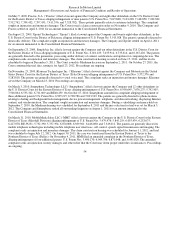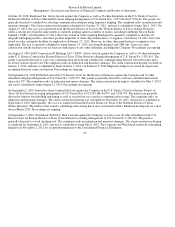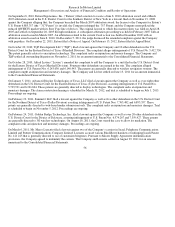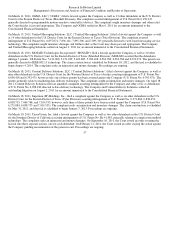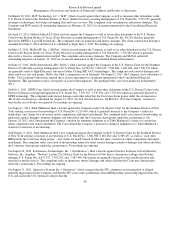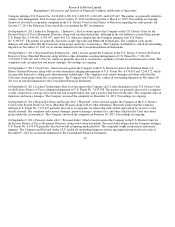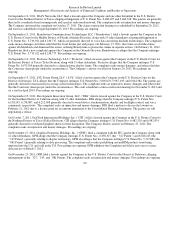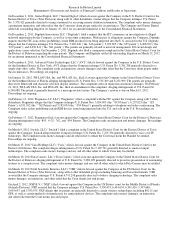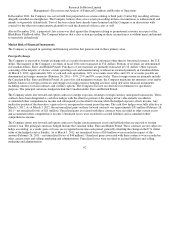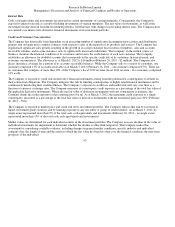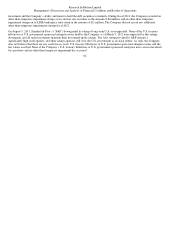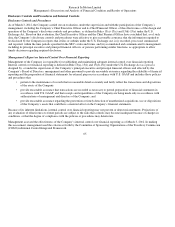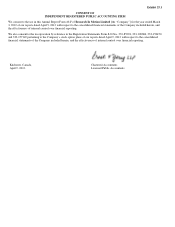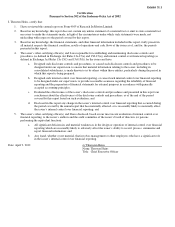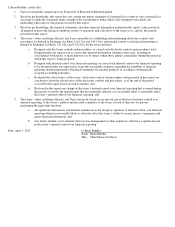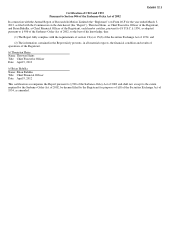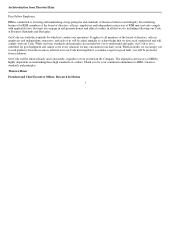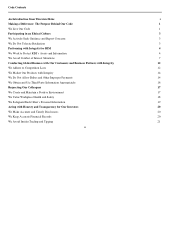Blackberry 2012 Annual Report Download - page 234
Download and view the complete annual report
Please find page 234 of the 2012 Blackberry annual report below. You can navigate through the pages in the report by either clicking on the pages listed below, or by using the keyword search tool below to find specific information within the annual report.
Research In Motion Limited
Management’s Discussion and Analysis of Financial Condition and Results of Operations
I
nterest Rate
Cash, cash equivalents and investments are invested in certain instruments of varying maturities. Consequently, the Company is
exposed to interest rate risk as a result of holding investments of varying maturities. The fair value of investments, as well as the
investment income derived from the investment portfolio, will fluctuate with changes in prevailing interest rates. The Company does
not currently use interest rate derivative financial instruments in its investment portfolio.
Credit and Customer Concentration
The Company has historically been dependent on an increasing number of significant telecommunication carriers and distribution
partners and on larger more complex contracts with respect to sales of the majority of its products and services. The Company has
experienced significant sales growth, resulting in the growth in its carrier customer base in terms of numbers, sales and accounts
receivable volumes, and in some instances, new or significantly increased credit limits. The Company, in the normal course of
business, monitors the financial condition of its customers and reviews the credit history of each new customer. The Company
establishes an allowance for doubtful accounts that corresponds to the specific credit risk of its customers, historical trends, and
economic circumstances. The allowance as at March 3, 2012 is $16 million (February 26, 2011 - $2 million). The Company also
places insurance coverage for a portion of its accounts receivable balances. While the Company sells to a variety of customers, one
customer comprised 13% of accounts receivable as at March 3, 2012 (February 26, 2011 – one customer comprised 15%). There are
no customers that comprise of more than 10% of the Company’s fiscal 2012 revenue (fiscal 2011 revenue – two customers comprised
11% each).
The Company is exposed to credit risk on derivative financial instruments arising from the potential for counterparties to default on
their contractual obligations. The Company mitigates this risk by limiting counterparties to highly rated financial institutions and by
continuously monitoring their creditworthiness. The Company’s exposure to credit loss and market risk will vary over time as a
function of currency exchange rates. The Company measures its counterparty credit exposure as a percentage of the total fair value of
the applicable derivative instruments. Where the net fair value of derivative instruments with any counterparty is negative, the
Company deems the credit exposure to that counterparty to be nil. As at March 3, 2012, the maximum credit exposure to a single
counterparty, measured as a percentage of the total fair value of derivative instruments with net unrealized gains was 30% (February
26, 2011 – 59%).
The Company is exposed to market price and credit risk on its investment portfolio. The Company reduces this risk by investing in
liquid, investment grade securities and by limiting exposure to any one entity or group of related entities. As at March 3, 2012, no
single issuer represented more than 9% of the total cash, cash equivalents and investments (February 26, 2011 – no single issuer
represented more than 19% of the total cash, cash equivalents and investments).
Market values are determined for each individual security in the investment portfolio. The Company assesses declines in the value of
individual investments for impairment to determine whether the decline is other-than-temporary. The Company makes this
assessment by considering available evidence, including changes in general market conditions, specific industry and individual
company data, the length of time and the extent to which the fair value has been less than cost, the financial condition, the near-term
prospects of the individual
63


